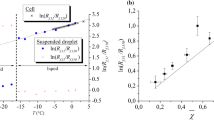Abstract
This article is dedicated to develop an experimental approach for directly visualizing the global freezing phase change behavior of micro liquid droplets. The infrared (IR) thermograph was proposed to image the basic solidification phenomena of droplet and to acquire its temperature variations during the transient process. In particular, the volumetric recalescence event, regarded as initiation of freezing, was revealed by IR images for the first time. Preliminary results demonstrated that the involved temperature transition due to release of the latent heat can be accurately characterized by evident color break in IR images. Further, experiments were also performed simultaneously on three kinds of droplets made of pure water, dimethylsulfoxide (DMSO) and nano liquid to grasp more precise temporal and spatial temperature distribution. Types of the occurring solidification and the initial frozen volume produced from the recalescence were generally discussed. The IR monitoring method suggests a straightforward way for detecting the freezing phase change activity and its temperature evolution at micro scale.






Similar content being viewed by others
References
Zuberi B, Bertram AK, Cassa CA, Molina LT, Molina MJ. Heterogeneous nucleation of ice in (NH4)2SO4–H2O particles with mineral dust immersions. Geophys Res Lett. 2002;29:1421–4.
Knight CA. Ice nucleation in the atmosphere. Adv Colloid Interface Sci. 1979;10:369–95.
Hills BP, Goncalves O, Harrison M, Godward J. Real time investigation of the freezing of raw potato by NMR microimaging. Magn Reson Chem. 1997;35:S29–36.
Zachariassen KE, Kristiansen E. Ice nucleation and antinucleation in nature. Cryobiology. 2000;41:257–79.
Fletcher NH. On ice-crystal production by aerosol particles. Meteorol J. 1959;16:173–80.
Liu XY. In: Sato K, Furukawa Y, Nakajim K, editor. Advances in crystal growth research. Amsterdam: Elsevier Science Publishers B.V.; 2001. p. 42–8.
Mazur P, Leibo P, Chu EH. A two-factor hypothesis of freezing injury: evidence from Chinese hamster tissue-culture cells. Exp Cell Res. 1972;71:345–55.
Yang Y, Liu J. Numerical stimulation on operating process of ice valve for controlling micro/nano fluidics. Chin J Sens Actuators. 2006; 19:2022–24 (In Chinese).
Yang Y, Liu J. Numerical simulation on operating process of freeze tweezer for manipulation of micro/nano objects. Chin J Sens Actuators. 2006; 19:1673–76 (In Chinese).
Diller KR, Cravalho EG. Cryomicroscopic investigation of intracellular ice formation in frozen erythrocytes. Cryobiology. 1971;8:398–406.
Namperumal R, Coger R. A new cryostage design for cryomicroscopy. J Microsc. 1998;192:202–11.
Petersen A, Schneider H, Rau G, Glasmacher B. A new approach for freezing of aqueous solutions under active control of the nucleation temperature. Cryobiology. 2006;53:248–57.
Watanabe K, Mizoguchi M. Ice configuration near a growing ice lens in a freezing porous medium consisting of micro glass particles. J Cryst Growth. 2000;213:135–40.
González-Pérez A, Olsson U. Cryo-fracture TEM: direct imaging of viscous samples. Soft Matter. 2008;4:1625–9.
Hindmarsh JP, Wilson DI, Johns ML, Russell AB, Chen XD. NMR verification of single droplet freezing models. AIChE J. 2005;51:2640–8.
Menzel MI, Han SI, Stapf S, Blümich B. NMR characterization of the pore structure and anisotropic self-diffusion in salt water ice. J Magn Reson. 2000;143:376–81.
Hindmarsh JP, Buckley C, Russell AB, Chen XD, Gladden LF, Wilson DI, Johns ML. Imaging droplet freezing using MRI. Chem Eng Sci. 2004;59:2113–22.
Kousksou T, Jamil A, Gibout S, Zeraouli Y. Thermal analysis of phase change emulsion. J Therm Anal Calorim. 2009;96:841–52.
Nitsch K. Thermal analysis study on water freezing and supercooling. J Therm Anal Calorim. 2009;95:11–4.
Liu J, Zhou YX. Freezing curve-based monitoring to quickly evaluate the viability of biological materials subject to freezing or thermal injury. Anal Bioanal Chem. 2003;377:173–81.
Błogowska K, Domański R. Noninvasive measurement of temperature field in natural covection of solidifying saline water. In: Proceeding of the 3rd IASME/WSEAS international conference on heat transfer, thermal engineering and environment. Corfu, Greece; 2005. p. 35–38.
Wisniewski TS, Kowalewski TA, Rebow M. Infrared and liquid crystal thermography in natural convection. In: 8th International symposium on flow visualization. Edinburgh; 1998. p. 212.1–8.
Bramson MA. Infrared radiation: a handbook for applications. New York: Plenum Press; 1968.
Wolfe WL, Zissis GJ. The infrared handbook. Washington: Office of Naval Research, Department of the Navy; 1978.
Hindmarsh JP, Russell AB, Chen XD. Experimental and numerical analysis of the temperature transition of a suspended freezing water droplet. Int J Heat Mass Trans. 2003;46:1199–213.
Hu H, Larson RG. Evaporation of a sessile droplet on a substrate. J Phys Chem B. 2002;106:1334–44.
Hindmarsh JP, Wilson DI, Johns ML. Using magnetic resonance to validate predictions of the solid fraction formed during recalescence of freezing drops. Int J Heat Mass Trans. 2005;48:1017–21.
Kucherov AN. Sublimation and vaporization of an ice aerosol particle in the form of thin cylinder by laser radiation. Int J Heat Mass Trans. 2000;43:2793–806.
Gao W, Smith D, Sego D. Freezing behavior of freely suspended industrial waste droplets. Cold Regions Sci Technol. 2000;31:13–26.
Acknowledgements
This study was partially supported by the Specialized Research Fund for the Doctoral Program of Higher Education, the NSFC, and Tsinghua-Yue-Yuen Medical Sciences Fund.
Author information
Authors and Affiliations
Corresponding author
Rights and permissions
About this article
Cite this article
Li, F.F., Liu, J. Thermal infrared mapping of the freezing phase change activity of micro liquid droplet. J Therm Anal Calorim 102, 155–162 (2010). https://doi.org/10.1007/s10973-010-0995-2
Received:
Accepted:
Published:
Issue Date:
DOI: https://doi.org/10.1007/s10973-010-0995-2




